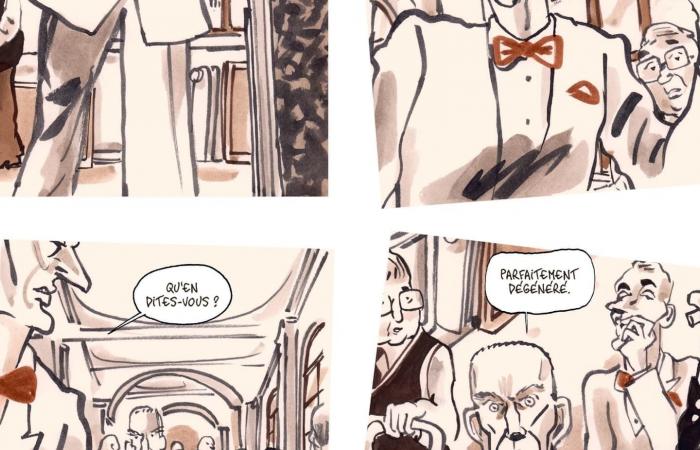Luz traces the history of a painting considered “degenerate” by the Nazis in a book which implicitly evokes the attack against Charlie Hebdo and the violence that ignorance of art can cause.
After the success of its adaptation of Vernon Subutex by Virginie Despentes and her farce on masculinity TestosterrorLuz returns with Two naked girls. The story of a painting, Two naked girls by the artist Otto Mueller, considered “degenerate” art then plundered by the Nazis before disappearing into the limbo of history.
A story told in an original way, from the point of view of the painting, in an album which denounces the resurgence of the extreme right. And which also reminds us, almost ten years after the attack on the satirical weekly Charlie Hebdothe dangers of censorship and the violence that ignorance of art and drawing can cause.
“It’s not that unconscious,” says Luz in an interview with BFMTV. With Two naked girlshe intends to answer a question “to which (he) still does not have the answer” since the attack of January 7: “What is it to be a survivor?” A word that he himself always refused to use.
“Bringing what a survivor can experience”
“Apart from a very tautological answer – I am a survivor because I survived – I don’t have too many other answers,” he analyzes. “Especially since it’s a label that was stuck to us (after January 7) and which is not a label that we stick to ourselves. I never knew how to talk about That.”
“As soon as I am asked questions about January 7, I answer a little, but I also hide. It’s difficult,” continues the former cartoonist, who has become a figure in the 9th art. “Since I am about to arrive (at the 10th anniversary of the attacks), I will not be able to escape this question. Rather than being asked the question, I want it to be me who asks it.”
With Two naked girls“I wanted to make a comic strip that would justify people asking me questions on the subject,” he explains again. “Maybe the only way I could answer these questions was to make (readers) experience what I experienced, what a survivor can experience.”
Graphic escape game
Except that Luz, after several autobiographical comics (Catharsis, Indelible), no longer wants to draw himself or talk about himself so directly. “My current life has no fictional significance. I don’t want to draw it. (I’m more comfortable) passing through something that is not a person.”
Two naked girls therefore places the reader in the place of the hated drawing, threatened with destruction. The album allows us to understand “what it is like to be stigmatized without being able to react”. But also “what it is like to be tossed around by history, to be part of history without having asked for it, to see the world from a distance without being able to react.”
This feeling, Luz has already represented it on the cover of Catharsis. He had drawn himself there with bulging eyes, unable to look away from the killing of January 7. In Two naked girlsthe reader puts himself in his place. But, at the end of the album, he escapes the horrors. “This comic is almost a graphic escape game!” laughs Luz.
A fairly rare experience
Two naked girls offers “a fairly rare experience”, underlines Luz: plunging “into an era without social networks” where “the judgment of a work is done solely through contact with it”. The painting is only revealed at the end. Throughout the story, the reader is “forced to imagine it through the judgment of others.”
Two naked girls marks a new beginning for him. The designer, who has always tended to overload his plates with texts and drawings, does the opposite here. The boards are ventilated. The white of the paper dominates. “It’s one of my rare books that I still open after reading it. It calms me down,” he says.
After this album, he rests. “It’s a book that involved a lot of things that required a lot of effort from me.” He has no specific project, but has picked up his brushes again. “The first thing I did, after this comic, was to draw in black and white. And to make an angry character. That’s all we can say.”







